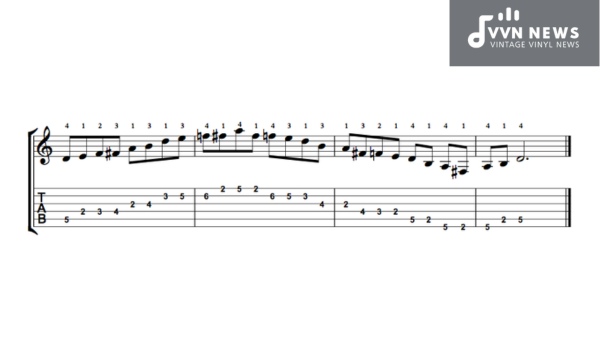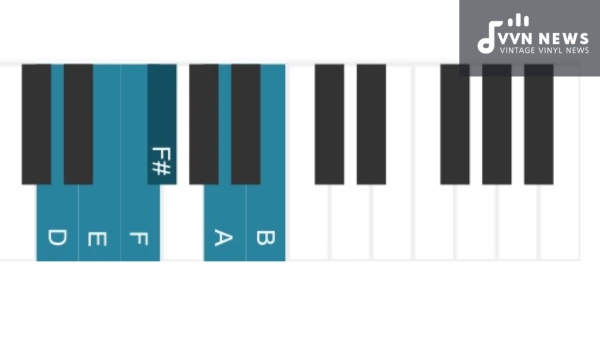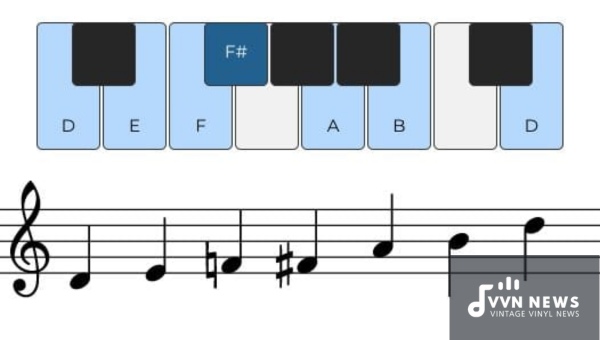If you’ve ever found yourself tapping your foot or swaying along to the soulful progressions of a blues tune, you’re likely hearing the seductive dance of blues scales at play.
Among these musical charms lies the D Major Blues Scale, a particular sequence of notes offering a rich tapestry of emotional expression.
This scale is more than just another tool in a musician’s arsenal—it’s a gateway to improvisational freedom and creative storytelling through melody.
In this blog post, I’ll guide you through the ins and outs of this compelling scale, including its structure and how to incorporate it into your playing.
With this knowledge in hand, you’ll be on your way to crafting those expressive solos and fills that give blues music its distinctive character.
Composition of D Major Blues Scale
The composition of the D Major Blues Scale is a blend of traditional major tonality with a hint of bluesy inflection, courtesy of an added flatted third, also known as the blue note.
The scale comprises six notes, starting with D – the root note. Here’s a breakdown in sequence:
- D (Root)
- E (Major 2nd)
- F (Flatted 3rd) – The Blue Note
- F# (Major 3rd)
- A (Perfect 5th)
- B (Major 6th)
Taking the form D-E-F-F#-A-B, this scale allows musicians to weave in and out of major brightness and minor moodiness, with the blue note offering a unique color characterizing that signature blues feel.
To quickly utilize this scale in your play, remember that these notes can be played in any octave and translated to various instruments.
Whether you’re constructing leads or enriching rhythms, integrating this blend into your performances can add layers of sonic depth to your music.
5 Different Shapes of D Major Blues Scale

When you dive into the world of blues scales, you’ll discover that the D Major Blues Scale can be played in various shapes across your instrument’s neck or keyboard. Each shape offers a unique pathway to this vibrant sound.
Here, I’ll introduce you to five distinct shapes that will significantly enhance your fluency in navigating through the scale.
Also Read: A Sharp Minor Pentatonic Scale [Unique Harmonic Possibilities]
Open Position (Shape 1)
The open position is typically the first that players learn. It utilizes the open strings on a guitar in conjunction with fretted notes and is an ideal starting point for beginners.
- Start on the open D string (the fourth string) on your guitar.
- Play these fretted notes in sequence: open D (D), E (2nd fret), F# (4th fret), G (5th fret), A (open 5th string), Bb (1st fret on A string).
- This pattern gives you immediate access to the root note without stretching your fingers too far along the fretboard.
Using The Fifth Fret (Shape 2)
The fifth-fret position starts on the fifth fret and is often favored for its comfortable hand positioning and ease of movement.
- Begin with your index finger on the fifth fret of the A string (D note).
- Proceed through this sequence: D (5th fret A string), E (7th fret A string), F# (9th fret A string), G (10th fret A string), followed by A and Bb found on their respective spots on the D string.
- This shape serves as an introduction to moving up and down the neck rather than staying within a box pattern.
The Box Shape Around 7th/10th Frets (Shape 3)
Box shapes are concise and easily memorizable patterns that allow expressive flexibility.
- Position yourself around the seventh to tenth freights, initiating from D located on the third finger, 7th-fret G-string.
- Cycle from there: E with pinky on 9th, shift to B-string for F# at 7th, then G at 8th.
- Make use of fingers efficiently by sliding or stretching when needed.
Using Two Strings (Shape №4)
Focusing on two strings allows for fast melodic runs while staying at a specific region of your instrument’s neck.
- Initiate from D located at G-string’s 7th.
- Progressively hit E(9th), drop to B-string for F#(7), continue through G(8) before capping off with A(10) followed by Bb at a higher pitch with a shift to 12.
- It emphasizes greater note clarity due to minimal hand repositioning in rapid succession.
Extended Range Shape (#5)
For those who embrace extended ranges, utilizing more than one octave broadens expressiveness remarkably.
- Start low at D(E-string/10), work upwards across strings incorporating audible slide when crossing from G(A-10) transitioning upwards towards higher octave iterations.
- Route yourself along till reaching uppermost register tones ensuring fluidity amongst transitions across octaves.
- Mastering this path gears you towards ultimate proficiency within intricate riffs derivation as well as improv tangents an integral aspect deeply rooted in blues’ essence.
By understanding these five shapes of the D Major Blues Scale, you will unlock vast territories within your instrument where creativity knows no bounds.
Practice each shape diligently and watch yourself grow not only as a musician but an authentic storyteller painting emotions through every note’s rise and fall within this soul-stirring scale.
Also Read: B Flat Minor Pentatonic Scale [Create Emotive Music In Minutes]
D Major Blues: Major and Minor Tones
The enchanting quality of the D Major Blues Scale lies within its hybrid nature, where the scale fuses both major and minor tones.
This scale starts with the root note D, followed by the major second E and then introduces a blue note, F, which is a lowered third from the scale’s major counterpart.
It is this blue note that provides the scale with its distinctive bluesy character.
What makes the blending of these tones so powerful is how they express different shades of emotion within a single piece.
The major notes—D, E, and A—evoke brightness and resolve. Meanwhile, the minor notes, specifically F which is also known as the flat third, alongside G (the perfect fourth), and A (perfect fifth), add depth with a touch of lament or tension.
Here’s how it looks:
- Major Tones: D (Root), E (Major Second), A (Perfect Fifth)
- Minor Tones: F (Blue Note/Minor Third), G (Perfect Fourth), A (Minor Seventh)
When you blend these together in your playing, you create a rich tapestry of sound that’s both familiar and hauntingly unique to blues music.
Understanding how to utilize these tones provides an excellent foundation for expressive blues improvisation.
Incorporating mixture of major brightness and minor melancholy captures listeners’ hearts, painting vividly emotional musical landscapes that are quintessentially blues.
Also Read: B Minor Pentatonic Scale [Inject Your Music With Dramatic Flair]
Backing Tracks for D Major Blues

When delving into the realm of blues improvisation, a reliable companion to have on hand is a good set of backing tracks.
These tracks serve as an impeccable framework upon which you can drape your D Major Blues explorations. Picture them as sonic canvases, patiently awaiting the splash of your melodic ideas.
For those eager to cut their teeth on D Major Blues, consider backing tracks that oscillate between the I-IV-V chord progression, such as a track cycling through D7, G7, and A7 chords.
This classic sequence offers fertile ground for practicing your phrasing and timing.
You can easily find myriad options online that cater to different grooves within the blues genre.
Websites like YouTube provide access to various backing tracks specifically designed for D Major Blues, ranging from slow-burning ballads to up-tempo shuffles.
Here are some examples of backing tracks that are great for experimenting with in D Major Blues:
- “Slow Blues in D” offers a sensual tempo perfect for expressive bends and soulful vibrato.
- “D Major Funky Blues” presents an opportunity to infuse blues riffs with a hint of funk’s rhythmic bounce.
- “12-Bar Blues in D” lays down the quintessential blues structure inviting you to master its form before breaking its rules.
By engaging with these tracks, you’re not just honing technical skills—you’re forging an intimate connection with the language of blues itself.
Importance of Ear Training in D Major Blues
When immersing yourself in the world of D Major Blues, ear training emerges as an essential skill.
It’s pivotal for recognizing chord progressions and nuances that make blues music resonate with its listeners. Here’s why honing your ear is crucial:
Developing Improvisation Skills: The heart of blues lies in its improvisation.
With a trained ear, you can effortlessly navigate through the D Major Blues scale and craft solos that feel both spontaneous and cohesive.
Quick Adaptation: By sharpening your listening abilities, you’re better equipped to adapt to different backing tracks or band dynamics.
You’ll be able to anticipate changes in tempo or key, ensuring a seamless performance.
Emotional Connection: A well-developed ear gets you closer to the emotional core of blues music.
As you discern minor from major tones within the D Major Blues scale, your playing becomes more expressive and soul-stirring.
Training your ears isn’t just about technical proficiency; it’s about internalizing the language of blues to communicate more effectively on your instrument.
It transforms notes on a page into stories told through strings, keys, and breaths—stories that echo the rich legacy of blues music itself.
Also Read: C Sharp Major Pentatonic Scale [Crisp & Clear Tones For Your Music]
Songs Using Major Blues Scale

The major blues scale is an integral component in the foundation of blues music, often used to craft memorable tunes and gripping solos across various genres.
Many songs not only from the realm of blues but also rock, jazz, and even pop employ the major blues scale for its warm and approachable sound that connects instantly with listeners.
A classic example is “Sunshine of Your Love” by Cream, where you can hear the major blues scale at work in its iconic riff.
Eric Clapton’s skillful guitar playing showcases how the major blues can be used to create powerful hooks that resonate with fans worldwide.
Another notable song that incorporates this scale is “Pride and Joy” by Stevie Ray Vaughan.
This track exemplifies how blending major and minor blues elements—using the major third for a warmer tone—can yield a groovy rhythm that defines a genre.
The Beatles, in their own innovative spirit, used the major blues scale notably in “Birthday,” providing a celebratory mood showcasing its versatility beyond traditional blues.
The joyful lead guitar part adds to the festive vibe while using this ostensibly simple scale.
Understanding these songs—and countless others rooted in the major blues scale—isn’t just about knowing what notes are played; it’s about feeling the emotive power behind each note.
The driving force behind this emotive power is how musicians bend, hammer, slide, and rhythmically play these notes to tell their story.
Influence of D Major Blues in Music Genres
The D Major Blues Scale has left its indelible mark across a spectrum of music genres, far beyond the dimly lit corners of smoky blues clubs.
Its reach extends into the realms of rock, jazz, and even pop; artists harness its raw emotional power to articulate intricate musical stories.
Rock ‘n’ Roll
The scale’s influence on rock music is undeniable. Legendary figures like Chuck Berry and Jimi Hendrix have utilized it to craft some of the most memorable licks that define the genre’s edgy sound.
The famous opening riff of Hendrix’s “Purple Haze” is an excellent testament to this.
Jazz
In jazz, the D Major Blues Scale adds a layer of soulfulness to compositions. Jazz virtuosos frequently employ it for improvisation, delivering a warm yet unexpected twist to their sophisticated pieces.
Country Music
Even country artists dip into this well, pulling up buckets brimming with bluesy twang, infusing their melodies with an arresting blend of nostalgia and grit.
No matter the style, incorporating the D Major Blues Scale can bring forth a whirlwind of emotions—ranging from joyous rapture to deep sorrow.
It is this emotional versatility that has established the scale as a fundamental ingredient in diverse musical recipes.
Also Read: E Major: Scale And Chords [Exciting Sounds For Your Compositions]
FAQs about the D Major Blues Scale
What notes make up the D Major Blues Scale?
The D Major Blues Scale consists of the following notes: D, E, F, F#, A, and C.
Can I use the D Major Blues Scale over any chord progression?
While you can experiment with it, the scale is most harmonious over D7, G7, and A7 chords or a standard I-IV-V blues progression in the key of D.
Is there a difference between the Major and Minor Blues Scale in D?
Yes, the D Minor Blues Scale has different intervals and includes different notes: D, F, G, Ab (G#), A, and C.
How can I practice the D Major Blues Scale effectively?
Incorporate it into your practice by using backing tracks in d major blues or composing simple licks and riffs that emphasize its unique tones.
Are there any famous songs that utilize the D Major Blues Scale?
Many blues songs use this scale; for example, you might hear its influence in classics like “Crossroads” by Cream or “The Thrill is Gone” by B.B. King.
Conclusion
Embracing the D Major Blues Scale is a thrilling leap into the heart of musical expression.
I encourage you to practice diligently, listen to blues legends for inspiration, and trust your ear—your best guide in mastering this scale’s nuances.
Remember, it’s the intricate blend of major and minor tones that infuses your playing with genuine soul.
Finally, don’t just learn the scale; make it yours by experimenting and playing along with backing tracks. This isn’t just theory—it’s the doorway to your own blues narrative ready to be told.








